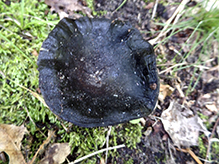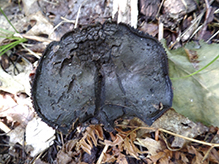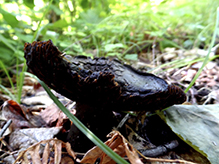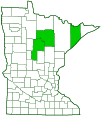Blackening Russula
(Russula albonigra)
Conservation • Description • Habitat • Ecology • Distribution • Taxonomy
Conservation Status |
|
|||||||
| IUCN Red List | not listed |
|||||||
| NatureServe | NNR - Unranked |
|||||||
| Minnesota | not listed |
|||||||
Description |
||
Blackening Russula is a large, widely distributed, gill mushroom. It occurs in eastern Europe, North America, and Mexico. In the United States it occurs east of the Mississippi River and west of the Great Plains, but is absent in-between and mostly absent from the southeast. It is uncommon in Minnesota. It is found in the summer and fall, scattered or in groups, in deciduous and mixed woodlands. It grows on the ground under deciduous or coniferous trees. It is ectomycorrhizal, obtaining its nutrients from the rootlets of trees and providing neutral or positive feedback. The cap is convex when young. As it matures it flattens out, becoming broadly convex or depressed at the center. With age it eventually becomes broadly depressed in the center. The mature cap is 2¾″ to 8″ (7 to 20 cm) wide. When young it is white, hairless, smooth, dry, and sometimes waxy to the touch. It soon turns brownish, gray, or blackish-brown, and eventually almost black. It does not have an intermediate red stage. If the white cap is broken or bruised, it will turn dark brown or black in about 20 minutes. It will not turn red. The upper skin cannot be easily peeled off. The gills are thick and are moderately or almost broadly spaced. There are usually short gills alternating with the long gills. The long gills are broadly attached to the stalk and may slightly run down the stalk. They are white at first, soon turning brownish or grayish, and eventually turning almost black. The stalk is 1¼″ to 5″ (3 to 13 cm) long and ¾″ to 2″ (2 to 5 cm) thick. It is solid, stiff, and very hard. It is white at first, soon turning brownish or grayish, and eventually turning almost black. The flesh is edible and the taste is mild if thoroughly cooked. However, eating is not recommended due to its similarity to a poisonous, closely related, Asian species. The spore print is white. |
||
Similar Species |
||
Habitat and Hosts |
||
Woodlands. Tree rootlets. |
||
Ecology |
||
Season |
||
Summer and fall |
||
Distribution |
||||
|
Sources |
|||
| 11/17/2022 | ||||
Occurrence |
||||
Uncommon |
||||
Taxonomy |
|||
| Kingdom | Fungi (Fungi) | ||
| Subkingdom | Dikarya | ||
| Phylum | Basidiomycota (Basidiomycete Fungi) | ||
| Subphylum | Agaricomycotina (Higher Basidiomycetes) | ||
| Class | Agaricomycetes (Mushrooms, Bracket Fungi, Puffballs, and Allies) | ||
| Subclass | Agaricomycetidae | ||
| Order | Russulales | ||
| Family | Russulaceae (milkcaps, brittlegills, and allies) | ||
| Genus | Russula (brittlegills) | ||
| Subgenus | Compactae | ||
| Subsection | Nigricantinae | ||
Some authorities believe Russula albonigra is restricted to Europe. They claim that the North American species is Russula dissimulans, which may be the same species as (conspecific with) Russula nigricans. The North American species was separated in 2008. Most European sources accept the separation. Most American sources do not. |
|||
Synonyms |
|||
Agaricus alboniger Russula adusta var. albonigra Russula albonigra var. pseudonigricans Russula nigricans var. albonigra |
|||
Common Names |
|||
Blackening Brittlegill (Europe) Blackening Russula |
|||
Glossary
Ectomycorrhizal
A symbiotic, neutral or beneficial relationship between a fungus and the tiny rootlets of a plant, usually a tree, where the hyphae surround but do not penetrate the rootlets.
Visitor Photos |
|||||
Share your photo of this fungus. |
|||||
| This button not working for you? Simply email us at info@MinnesotaSeasons.com. Attach one or more photos and, if you like, a caption. |
|||||
Luciearl |
|||||
 |
 |
||||
 |
|||||
MinnesotaSeasons.com Photos |
|||||
|
|||||

Slideshows |
||

Visitor Videos |
|||
Share your video of this mammal. |
|||
| This button not working for you? Simply email us at info@MinnesotaSeasons.com. Attach a video, a YouTube link, or a cloud storage link. |
|||
Other Videos |
|||

Created: 10/5/2020
Last Updated:


